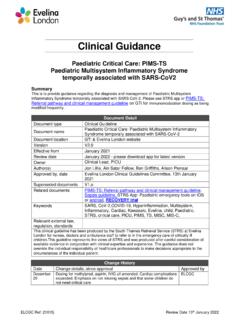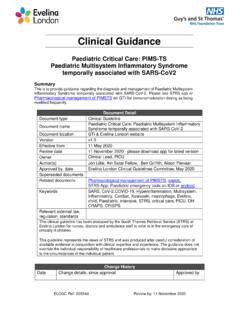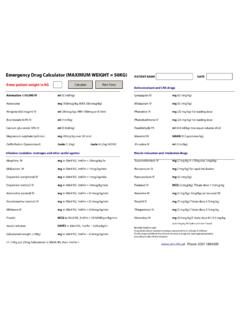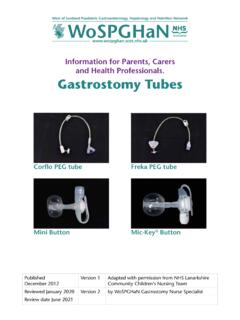Transcription of gastrostomy at home (PEG) - Evelina London
1 How to care for your child's gastrostomy at home (PEG). Information from the Children's Community Nursing Team (CCNT) - Lambeth and Southwark What is a PEG gastrostomy ? A percutaneous endoscopic gastrostomy (PEG) is a small feeding tube which is inserted directly into the stomach so that your child can receive feed, fluid and medication without swallowing. It will give them a safe and long- term method of getting nutrition. It is held into place in the stomach by a small plastic disc called a bumper. There are many medical reasons that a child may need a PEG inserted. The main reason is that they are currently unable to take enough nutrition orally to help them grow and develop. In order to help them with their nutritional intake a PEG feeding tube has been inserted.
2 Below is an example of freka PEG, but there are other types of PEGs such as a Corflo that are secured using a bumper to hold the tube in place that require similar care to the freka . Your community nurse will be able to advise you further. Caring for your child's gastrostomy You will find that the stoma (the small opening in the skin around where the gastrostomy is fitted). should be closed 7-10 days after the tube has been inserted. The skin around the stoma site can take around 4-6 weeks to heal. It is normal to have some leaking around the stoma site when the PEG has first been inserted. After two weeks the wound will be healed so your child will be able to have a shower or shallow bath. Do not submerge the PEG in water. This is when the first turn of the PEG will take place.
3 After six weeks the PEG can be fully submerged in water and your child will be able to do wet activities such as swimming. This is when the first advance will take place (see the section below about advancing the freka PEG). After the first six weeks both the turn and the advance can be done at the same time and continued at least twice a week. Once you are home the stoma site should be cleaned twice a day with cooled boiled water and gauze or a cotton wool pad. After cleaning make sure that the area under the fixation plate is dried to stop irritation. 2 of 8. Turning the freka PEG. The PEG should be rotated 360 in a full circle, against the skin to avoid the bumper becoming embedded. This should be done at least twice a week. 1 Wash your hands thoroughly with soap and water.
4 2 Hold the end of your child's PEG. 3 Rotate the end of the PEG. 4 The tube should be rotated 360 in a full circle. 3 of 8. Advancing the freka PEG. The PEG should be advanced by 4-6cm to prevent buried bumper syndrome (where the plastic disc holding the PEG in place sticks to the lining of the stomach wall). This should be done at least twice a week as well. The freka /fixation plate (triangle) should be secured 2-3mm away from the skin. If your child has a Coreflo PEG use the same instructions as below (it's just a different design). 1 Wash hands thoroughly with 2 Clean the external plate as 3 Open the fixation catch. soap and water. advised by your healthcare professional. 4 Detach tube from groove in 5 Move plate away from skin. 6 Clean tube and stoma area fixation plate.
5 And the underside of the plate, and dry thoroughly. 7 Push 4-6cm of the tube into 8 Gently pull back the tube to 9 Place the fixation plate back the stomach. feel resistance. to its original position (about 2-4mm away from the skin). 10 Re-insert tube in the groove 11 Close the fixation catch. 12 The fixation plate should sit well against the skin. 4 of 8. Changing a freka PEG end You should have been given a spare PEG end and clamp by your community nurses. PEG. ends do not require regular changes and only need to be changed when they are broken. To keep the ends clean you can use a dedicated tooth brush to clean in difficult places when your child has a bath or shower. 1 Wash and dry 2 Close clamp on 3 Detach the outer 4 Attach the outer hands.
6 Tube. white ring from the white ring to the new ENFit end. coloured hexagonal fixing screw of the previous ENFit . connector. 5 Unscrew the old 6 Pull off the pin and 7 Replace the outer 8 Push the pin with hexagonal fixing remove the previous white ring back on to adaptor into the screw from the adaptor from the the hexagonal fixing tube. adaptor. tube. screw on the new PEG end and slide onto the tube. 9 If the connection is 10 Slide the fixing 11 Remove the outer loose, or the tube is screw towards the white ring to stretched, trim 1cm ENFit adaptor and prevent accidental off the tube length. screw together removal of the using the outer adaptor end. white ring. What can be given through a PEG? Only your child's feed, water and medication should be given via the PEG.
7 Your dietitian will be able to advise you on your child's feeding regime and arrange deliveries of the milk your child will need. It is important to make sure your child's tube is flushed regularly to keep it clean and help hydrate your child. 5 of 8. You must flush your tube: at the beginning and end of each feed when stopping and restarting a feed before and after giving medication and in between medication if more than one drug is being given 2-3 times a day if you are not presently giving feeds through the PEG tube You can use drinking water to flush your tube. Sterile water is not necessary unless advised by a healthcare professional. Problems with the PEG. If the tube leaks when feeding, contact your CCN team or clinical nurse specialist (CNS) for help.
8 If your child's PEG gets blocked never force the tube. Make sure all of the clamps are open and the tube is not kinked. Draw back any free fluid with a 60ml syringe and then try flushing with 50mls of warm water and leave for 30 minutes. If the blockage is obvious massage the area to encourage the blockage to break down and move. If the tube remains blocked, repeat the process above but with plain carbonated water (no flavouring). If the tube remains blocked, seek medical help from your CCNT or local hospital. If you have difficulty in advancing the PEG, try rotating it first. If you are still unable to advance the PEG seek medical help. If you have difficulty in rotating the PEG, wet the stoma site and try pushing the tube in by 1-2cm and then pull back out.
9 If you are still unable to rotate the PEG seek medical help. If you are still unable to advance contact the CCNT. Skin problems around the PEG. Problems with the skin around gastrostomies can be very common. If you are worried or concerned, please call the CCNT for advice. On the next few pages are some of the common problems that can be found with the skin around the gastrostomies, and information about how they are usually treated. Your child's gastrostomy device may look different to those shown in these pictures. Localised redness Causes: A gastrostomy site can become red for many reasons. It could be due to a small amount of leaking, the area rubbing, a change in weather or your child being unwell. Treatment: Increase the frequency of cleaning the stoma site.
10 After cleaning the stoma, barrier creams such as Proshield or Cavilon can be used on the area to try and prevent the area becoming sore. Review: No review needed. Referral: Barrier creams should be available on a repeat prescription. If you are unable to get this from your GP, contact the CCNT and ask for a prescription request. 6 of 8. Leakage of stomach content Causes: A gastrostomy site can leak stomach contents for different reasons. It could be because your child's stomach is full or the stoma is healing around the site. Treatment: Continue to clean the stoma site regularly with warm water. Apply a barrier cream to the stoma to keep the skin heathy. Check that PEG is positioned correctly, Review: Call the CCNT to arrange a visit for them to check everything is okay.








